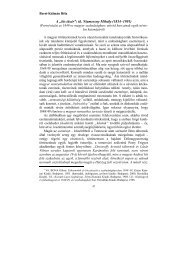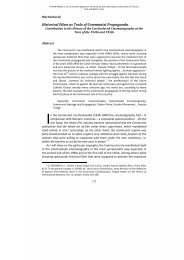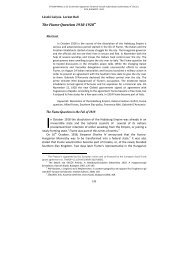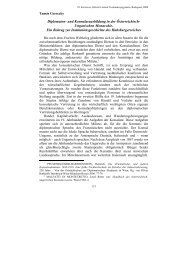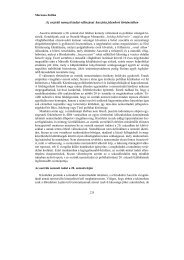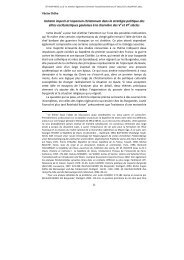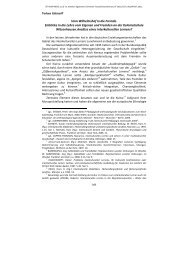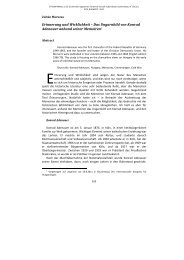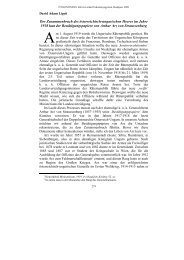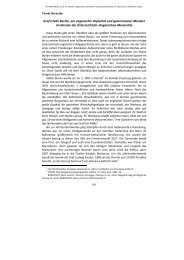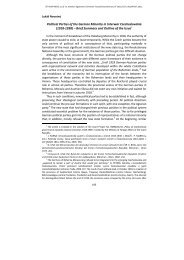The Molotov-Ribbentrop Pact - ELTE BTK Történelem Szakos Portál
The Molotov-Ribbentrop Pact - ELTE BTK Történelem Szakos Portál
The Molotov-Ribbentrop Pact - ELTE BTK Történelem Szakos Portál
You also want an ePaper? Increase the reach of your titles
YUMPU automatically turns print PDFs into web optimized ePapers that Google loves.
not expect strong resistance and hoped for a quick success. <strong>The</strong>y attacked in<br />
three directions: 1. in the North - aiming at Petsamo in order to cut supplies<br />
from the allies 34 - this was the only operation of the three that was successful to<br />
a certain extent; 2. In the South - aiming at Helsinki and other large cities; 3. in<br />
North Karelia. 35<br />
<strong>The</strong> Soviet Union had 26 divisions, one motorized army corps, five<br />
armoured brigades, and they were equipped with heavy artillery, 1000<br />
airplanes, 100 submarines and 2000 tanks. <strong>The</strong> Soviet army that attacked<br />
Finland consisted of approximately half a million men. On the other hand, the<br />
Finns had only 9 divisions and 75 airplanes 36 and approximately 120 000 men.<br />
<strong>The</strong> Finnish army had no anti-tank artillery, and they had virtually no antiaircraft<br />
defense, either. <strong>The</strong>ir few tanks – made in the 1920s and at the<br />
beginning of the 1930s – were out of date; likewise, both their fleet and air<br />
force were unsatisfactory. 37<br />
Despite all that, the Finish army held on for three months. <strong>The</strong> reason was<br />
simple: the Soviet troops had no winter military training and winter attires. <strong>The</strong><br />
Finns used skis and white clothes, their morale was excellent, while the Soviets had<br />
brown and thin clothes for the freezing snowy weather and they had only 1 to 3<br />
weeks training. Jacobson refers to the winter of 1939/1940 as the coldest in the<br />
century. 38 After losing too many soldiers, the Soviets tried to substitute the troops<br />
with ski-champions, most of whom died an inglorious death in the fields of<br />
Finland. 39 <strong>The</strong> Finnish tactic was simple, but effective, they let the Soviets get<br />
closer, cut the supply-lines back and rushed the convoy. <strong>The</strong> Finnish-front turned<br />
into a Soviet cemetery: approximately 300 000 Soviets died (officially 127 000). 40<br />
While the war raged over the border of the USSR and Finland, the Soviet<br />
leaders planned to install a puppet-government led by Finnish Communists,<br />
such as Otto W. Kuusinen. During the attack in December they created the<br />
People’s Democratic Government. 41 Kuusinen was a member of the Finnish<br />
Red Guard during the Finnish civil war. To install a puppet- government was a<br />
habitual (and temporal) measure by the Soviets: <strong>The</strong> Bolsheviks did it during<br />
the Russian civil war with Ukraine and other fugitive states.<br />
34 An English consession was in Petsamo, to trade with rare materials, like Nikkel.<br />
35 JACOBSON, Max: Finland in the new Europe. <strong>The</strong> center for strategic and international<br />
studies, Washington, 1998. 32.<br />
36 Ibid.<br />
37 MANNERHEIM, Carl Gustav von: Emlékiratok. A téli háború. (Memoir. <strong>The</strong> winter war).<br />
Püski, Budapest, 1997. 19.<br />
38 JACOBSON, Max: Finnország: mítosz és valóság. (Finland: myth and reality). Minerva,<br />
Budapest, 1990. 30.<br />
39 HELLER, Michail, NEKRICH, Alexandr: Orosz történelem (Russian history) vols II.<br />
Osiris, Budapest, 2003. 318.<br />
40 Ibid. 319-320.<br />
41 JACOBSON, Max: Finnország: mítosz és valóság. (Finland: myth and reality). Minerva,<br />
Budapest, 1990. 30.<br />
72



